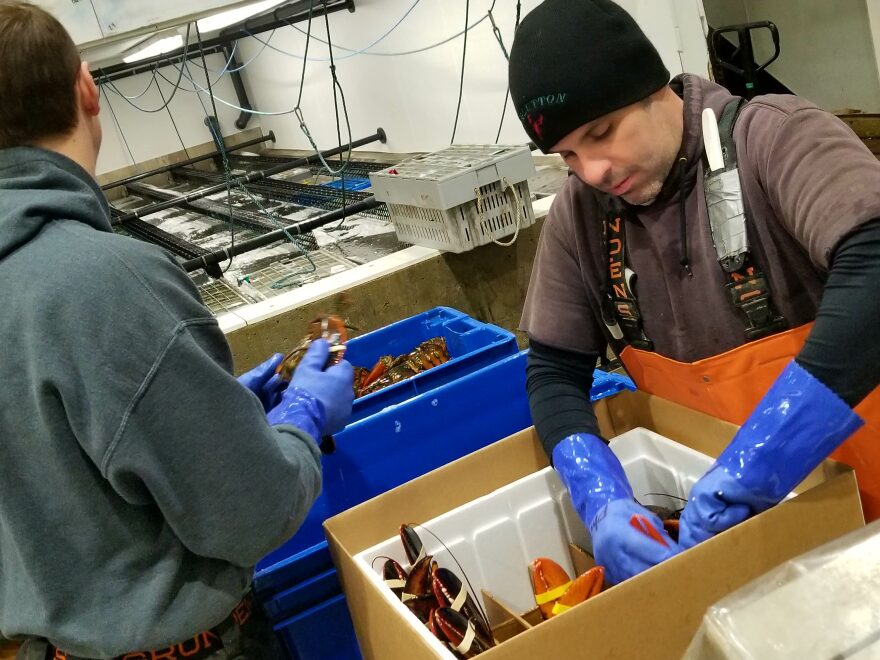Of all Maine's export products, one of the most logistically challenging is Homarus americanus. Fresh Maine lobster is now in demand all over the world, but it takes a lot of work to deliver the product to the other side of the planet while it's still fresh. In this installment of It CAN Get There From Here we visit a lobster dealer who's found a way to do it.
Lobster packing is a squeaky affair, but the workers who do it will tell you “you get used to the Styrofoam squeak after a while.”

A crew of five people is stuffing live lobsters into boxes, tail first, where they will ride upright, cradled in the Styrofoam partitions like bottles of wine. When this box is full, it will contain 30 pounds of live lobster, part of a 3000 pound order, that will be transported on a big plastic-wrapped pallet to any number of places.
“Right now they're packing an order that's going to be going to Asia. It's what we do almost daily,” says Tom Adams.
Adams opened Maine Coast Lobster in York just seven years ago. In its first year, the company shipped about one million pounds of lobster to a handful of locations. Last year, it shipped seven million pounds to 27 different countries, including "France, Spain, Italy, Belgium, China, Hong Kong, Korea. Vietnam, Thailand, Singapore…” and several others.

Adams has been in the lobster business for more than three decades, starting at the age of 15. After college, he worked his way into a sweat equity-based partnership in York, where he learned more about running the business side of things. When he launched Maine Coast Lobster, he knew he'd have to compete with a lot of well established companies for a share of the domestic fresh lobster market.
"Which we did, but Asia — especially China back in 2010, 2011, 2012 — was really finding a taste for our lobster. So emerging market? New company? It was a natural fit that we would grow quickly into that space, and we did."
Indeed; in February, Maine Coast shipped about 300 thousand pounds of lobster to supply Chinese New Year celebrations alone.
Shipping lobsters to Europe from Maine isn't necessarily any harder than shipping to California or Washington, so it made sense to do that. But getting fresh lobsters to Asia, and ensuring that they arrive alive and in good condition, is a challenge. Adams says they need to be handled like eggs. The lobsters are flown from Logan, JFK or Newark airports, sometimes on cargo planes, but also sometimes on passenger flights.

"It's extremely time sensitive,” he says. “We ask a lot out of live lobster to travel as far as southeast Asia and China and sometimes they extend to over 60 hours from the time we pack them to the time the customer receives them."
Ideally, lobster transit time should be more like 36 hours, but Adams says shipments are sometimes delayed by customs officials and arrive later, something he can’t control.
There are also other external forces that can affect his business, including a new trade deal between Canada and the EU. It makes Canadian lobsters tariff-free, which could make the Canadian product more attractive to European buyers.
"It's tough to say,” says Alex Puig. Puig is one of those European buyers. “You know it's still very recent and we're still trying to understand, what is the market really doing?"
Puig brings the lobster to Spain, where it's eaten in popular seafood dishes like paella. He says while the 8 percent tariff on U.S. lobster is significant, there are lots of other factors that buyers consider.
"Canada is not very well organized, very well logistically, okay?” he says. “So, you cannot reach as many places from Canada on a daily basis, and as fast, as you can from the U.S.”
Puig believes that Europeans will continue to buy Maine lobster during the summer time, when Canada's season is closed and their product is more expensive.
Even if he does lose some European clients, Tom Adams says he's optimistic.
"It will have its ups and downs like any business...but I'm still very bullish on the lobster industry,” Adams says.




